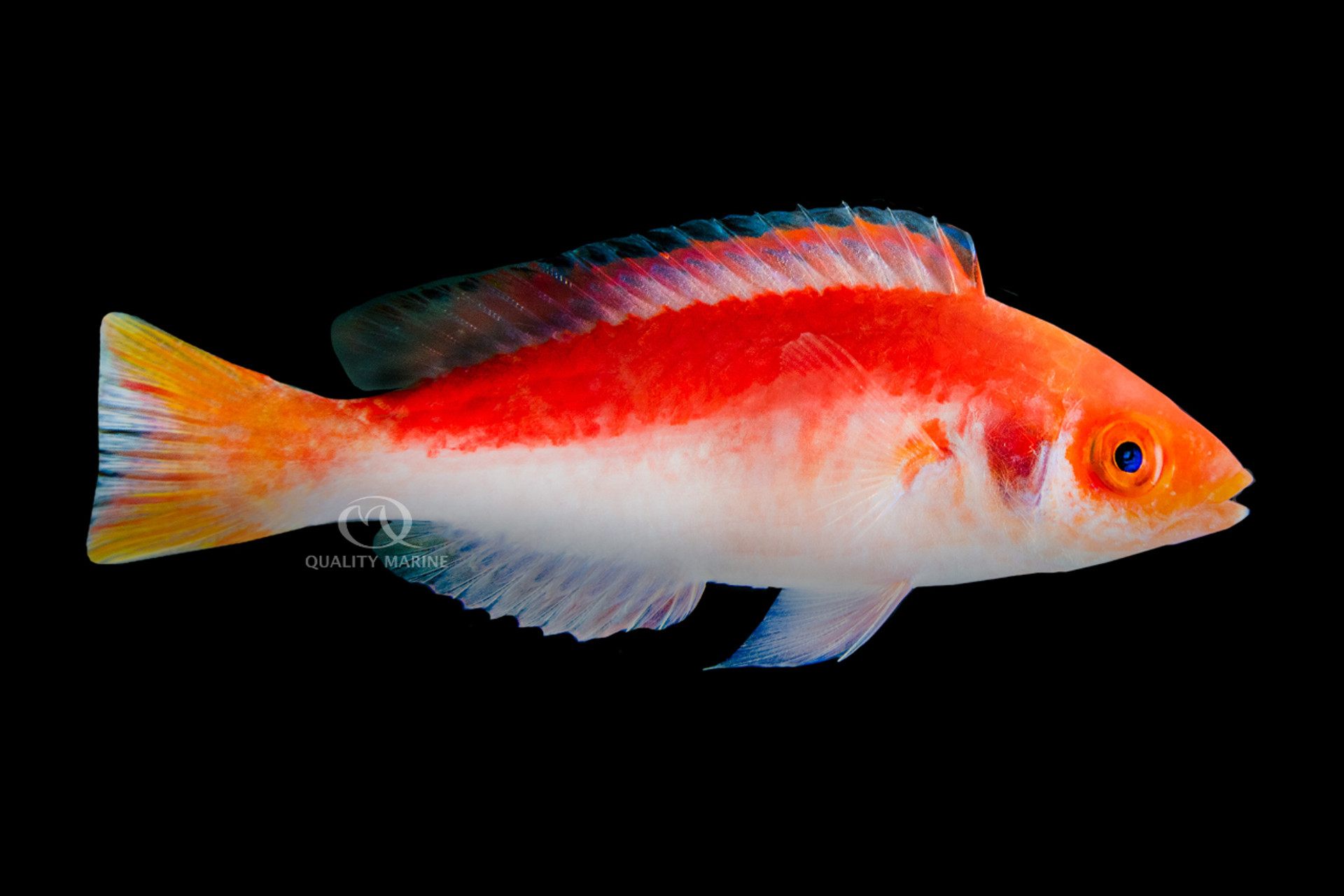Small, Gorgeous, Peaceful. What's not to like about Marjorie's Wrasse?!

Cirrhilabrus marjorie was so named to honor Marjorie Awai. Marjorie penned the book “A Guide to Hawaiian Marine Life”, at one time was the Curator of the Florida Aquarium and also worked in the ichthyology department at the Bishop Museum in Hawaii. She is married to Dr. Bruce Carlson, who was the Science Officer for (and one of the designers of) the Georgia Aquarium and former director of the Waikiki Aquarium on Oahu. Unsurprisingly, Cirrhilabrus marjorie goes by the common name Marjorie's Wrasse and is somewhat unique in that this is really its only common name all over the world. The fact that it comes from a small range (only Fiji) and is rarely collected for aquariums probably plays a role in this singular nomenclature.
Cirrhilabrus wrasses are all just beautiful, peaceful and excellent aquarium fish. Females are usually some shades of pink and males get showy colors. Marjorie's Wrasse is no exception to this rule. When in peak form, the males are stunners with ivory white bodies and a wide, deep reddish orange band along their backs. The dorsal fin is pale blue with a black bar, edged in neon blue; their tails are yellow with the same black, blue combination of the dorsal fin. They can also have four pale blueish stripes along their sides!
Even for fairy wrasses (as the genus Cirrhilabrus is commonly called) Cirrhilabrus marjorie is small. Males almost never get bigger than three inches long, and females are usually about a half inch shorter at maturity. Marjorie's Wrasses live in large groups and will form unique pairs for spawning time. There are usually more females than males in the groups, but these groups frequently feature multiple males. You can keep several of them together in the home aquarium to mimic this wild distribution, though we recommend you have a very large tank if you want to keep multiple males. They are found off reefs usually between 90 and 150 feet deep where they suspend in the water all day eating pretty much anything that floats by (which is usually zooplankton.)
In regard to appropriate aquariums for Marjorie's Wrasses, you could keep a small group, one male and two or three females in a 75-gallon aquarium. Obviously more could be kept, and you could mix them with other Cirrhilabrus wrasses, but you should go for a bigger tank in that case. They are about as reef safe as any fish can be and should not bother corals or other invertebrates at all (except food of course). They can be kept with other peaceful fish but could be picked on by overly aggressive fish and their fins are delectable targets for notorious nippers.
Offer them plenty of rocks to swim through, hide among and sleep in. They will tuck themselves into a fairly tight spot in the rocks and sleep there at night. They do well in high flow tanks, and your display should offer them a minimum of ten times the aquarium's water volume in gallons per hour (more would be better). The lighting at their natural depth is subdued, so acclimate them to reef intensity lighting slowly. Keep any tank that has Marjorie's wrasses in it covered. They don't necessarily jump, but they'll swim upward quickly if startled and can launch themselves out of the aquarium. They'll do best in water that is between 70-78 degrees. Specific gravity isn't too important as long as it is stable; anything in 1.021 to 1.026 will be fine. Keep nitrates low.
Once acclimated, your Marjorie's Wrasses will be very active swimmers during the day. In the wild, they constantly eat, and this actually helps them get acclimated to eating in the home aquarium, as they are very used to eating anything that floats past. Really the only barrier to getting them to eat is initial shyness, but this doesn't usually last long. You don't need to feed them all day long, but you should plan on feeding them at least twice per day, and more frequently, smaller meals would be a bonus. Here they get a mix of thawed Gamma Foods that relies heavily on Mysis, but also includes Brine plus Spriulina, Brine Plus Omega 3, Copepods, and Finely Chopped Prawn / Mussel. We also offer them the Nutramar Complete Pellets, which are a valuable tool for easily getting enough protein and a wide spectrum of nutrients.
We all love Cirrhilabrus wrasses here, and Marjorie's are a favorite for their mind-boggling colors, high activity level, ease of care and frankly, their rarity. You just don't see them all that often! You can keep them in groups, which makes them a great alternative to some of the harder to keep Anthias. They stay small but have a huge visual impact in your display. If you've been waiting for just the right fairy wrasse for your display, now is the time to visit your Local Fish Store and ask them about getting you a group of Marjorie's Fairy Wrasses from Quality Marine today!